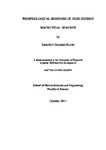MORPHOLOGICAL RESPONSE OF HIGH-ENERGY MACROTIDAL BEACHES
| dc.contributor.supervisor | Russell, Paul | |
| dc.contributor.author | Poate, Timothy George | |
| dc.contributor.other | Faculty of Science and Engineering | en_US |
| dc.date.accessioned | 2012-08-02T14:34:13Z | |
| dc.date.available | 2012-08-02T14:34:13Z | |
| dc.date.issued | 2012 | |
| dc.date.issued | 2012 | |
| dc.identifier | 733793 | en_US |
| dc.identifier.uri | http://hdl.handle.net/10026.1/1094 | |
| dc.description.abstract |
Spatial data collected over 3 years is presented to assess the extent of morphological variability under seasonal and storm waves at four high-energy macrotidal beaches. A novel approach is adopted to identify and classify the beach response which is used to assess the relative stability of the system to changes in the dominant forcing conditions. Field measurements and modelling simulations using XBeach provide further support for a storm dominated system exhibiting relative stability. Morphologically the beaches range from dissipative to intermediate and are characterised by low tide bar/rip morphology which plays a key role in the nearshore dynamics and beach safety. Located in the north coast of Cornwall the sites are exposed to high-energy waves that dominate the stability and behaviour of beaches in this region. The growing need for marine renewable energy in the UK has led to the deployment of a Wave Hub on the seabed off the north coast of Cornwall, designed to provide grid connection for wave energy devices (WECs). As a unique development much has been done to address concerns over potential impacts cause by arrays of WECs during its construction and operational lifetime; these predicted impacts include changes in the quality of waves for surfing and effects on the beach dynamics which determines beach safety through the presence of bar/rip features. In this thesis three years of monthly topographic surveys were collected from beaches in the proposed Wave Hub shadow zone to assess their morphodynamic variability. Realtime kinematic (RTK) GPS surveys were undertaken using an all-terrain vehicle to measure the three dimensional (3D) morphology at four beaches (Perranporth, Chapel Porth, Porthtowan and Gwithian) situated along a 23 km stretch of the north Cornish coast. In addition nearshore wave data, in-situ hydrodynamic measurements, local tide gauges and Argus video data allowed detailed analysis of process-response mechanisms for long term (yearly); seasonal (monthly); storm (weekly/daily); and tidal (hourly) morphological behaviour. Of particular interest was the degree to which the beaches displayed bar/rip morphology, characterised by the three dimensionality (3D) of beach response, which determines wave breaking and affects beach safety. Using a combination of measured shoreline variability and empirical beach classification schemes, the response to changes in the wave conditions at each beach have been assessed. The sites exhibited net long term accretion derived from the intertidal beach volume. Throughout the survey period intersite similarity in beach response was observed in response to storm waves, yet coupling between the seasonal wave climate and the beach morphology was not evident at any of the sites, due to the dominance of recovery phases following storm events. The role of increased wave conditions (exceeding Hs=4 m) during sustained storm events (> 50 hrs) led to offshore transport from the beach face to the subtidal bar region. Post-storm recovery was characterised by onshore transport and the development of substantial 3D low tide morphology. Under normal wave conditions (Hs=1.6 m) the dominant 3D features smoothed out as channels in-filled and bars reduced over a period of 2-3 months. This cyclicity was observed on ~3 occasions at the northern sites, while Gwithian remained more stable throughout; reflecting the more sheltered position of the beach. Overall the beaches exhibited a significant storm dominated morphological response cycle, unlike the more familiar winter/summer seasonal response. Nearshore bar behaviour at Perranporth and Porthtowan, assessed using ARGUS images, was dominated by offshore migration (ca.20 m/yr) following closely the net intertidal accretion, while bar shape exhibited changes over monthly periods. Intensive field studies of morphological change, nearshore current flows and surf zone wave conditions were undertaken at Porthtowan during small swell dominated waves and large energetic storm conditions in May and October 2010 respectively. The field data highlighted accretionary response under small swell dominated waves, and strong offshore directed undertow flows (0.5 m/s-1) during erosive energetic conditions (>Hs = 4m) which were then related to the monthly surveys. These results were applied to XBeach model simulations which helped further identify the importance of antecedent morphology and the complexities of intertidal geology in controlling beach response. The study provides the longest continuous record of beach morphology dynamics for macrotidal energetic sites and provides a valuable addition to work in this field. The dominance of storm driven morphological response was clear with highly threedimensional morphology developing under post storm conditions and continued beach evolution driven by the seasonal conditions. Antecedent morphology was found to be a key element of beach response with geological control an additional component. The projected reduction in wave conditions due to the Wave Hub and the natural variability observed indicates the sites are unlikely to shift significantly from their current dynamic state in response to the Wave Hub, and as such the potential impact on nearshore and beach dynamics is minimal. | en_US |
| dc.language.iso | en | en_US |
| dc.publisher | University of Plymouth | en_US |
| dc.subject | Macrotidal | |
| dc.subject | Cornwall | |
| dc.subject | Morphological change | en_US |
| dc.title | MORPHOLOGICAL RESPONSE OF HIGH-ENERGY MACROTIDAL BEACHES | en_US |
| dc.type | Thesis | |
| dc.identifier.doi | http://dx.doi.org/10.24382/4024 |
Files in this item
This item appears in the following Collection(s)
-
01 Research Theses Main Collection
Research Theses Main


